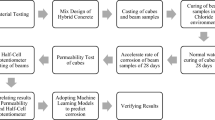Abstract
This work presents machine learning-inspired data fusion approaches to improve the nondestructive testing of reinforced concrete. The principal effects that are used for data fusion are shown theoretically. Their effectiveness is tested in case studies carried out on large-scale concrete specimens with built-in chloride-induced rebar corrosion. The dataset consists of half-cell potential mapping, Wenner resistivity, microwave moisture and ground penetrating radar measurements. Data fusion is based on the logistic regression algorithm. It learns an optimal linear decision boundary from multivariate labeled training data, to separate intact and defect areas. The training data are generated in an experiment that simulates the entire life cycle of chloride-exposed concrete building parts. The unique possibility to monitor the deterioration, and targeted corrosion initiation, allows data labeling. The results exhibit an improved sensitivity of the data fusion with logistic regression compared to the best individual method half-cell potential.






Similar content being viewed by others
Notes
There is a wide range of specifications for the critical corrosion-causing chloride content. The value 4 wt% is based on the DIN-EN 206 standard.
References
Ahmed M, Moselhi O, Bhowmick A (2018) Two-tier data fusion method for bridge condition assessment. Can J Civ Eng 45:197–214
Ann KY, Song H-W (2007) Chloride threshold level for corrosion of steel. Corros Sci 49:4113–4133
ASTM International—Standards Worldwide (2015) ASTM-C876: standard test method for corrosion potentials of uncoated reinforcing steel in concrete, USA
Barnes CL, Trottier J-F (2004) Effectiveness of ground penetrating radar in predicting deck repair quantities. J Infrastruct Syst 10:69–76
Blum A, Hopcroft J, Kannan R (2018) Foundations of data science. Cornell University, New York
CC Technologies Laboratories (2002) Incorporated; NACE International; Federal Highway Administration, “Corrosion Costs and preventive Strategies in the United States (FHWA-RD-01-156, R315-01)”. National Technical Information Service, Alexandria
Chen C-C (2012) Lateral waves in ground penetrating radar applications. In: Proceedings of the 14th international conference on ground penetrating radar, Shanghai
Cotič P, Jagličić Z, Niederleithinger E, Stoppel M, Bosiljkov V (2014) Image fusion for improved detection of near-surface defects in NDT-CE using unsupervised clustering methods. J Nondestruct Eval 33(3):384–397
Cui J, Huston DR, Arndt RW (2013) Data fusion for multiple-sensor nondestructive evaluation on concrete bridge deck. In: Proceedings of TRB 2013 annual meeting, Washington, DC
Dauberschmidt C (2006) Untersuchungen zu den Korrosionsmechanismen von Stahlfasern in chloridhaltigem Beton. Dissertation, RWTH Aachen, Aachen
Deutsche Gesellschaft für Zerstörungsfreie Prüfung (2014) DGZfP B 03 E—electrochemical half-cell potential measurements for the detection of reinforcement corrosion, Berlin
Fiedler U (2001) NDT data fusion in civil engineering. In: Gros XE (ed) Applications of NDT data fusion. Kluwer, Norwell, pp 193–204
Fisher RA (1936) The use of multiple measurements in taxonomic problems. Ann Eugen 7:179–188
Force Technology (2015) ERE 20 reference electrode (Online). http://www.forcetechnology.com/en/Menu/Products/Concrete-monitoring/Concrete-monitoring-probes/ere20referenceelektrode.htm. Accessed 12 Mar 2015
Garnier V, Ploix MA, Breysse D (2011) Data fusion to improve the concrete diagnosis. Nondestruct Test Mater Struct 6:1241–1246
Gros XE (1997) NDT data fusion. S. E. Press, Bodmin
GSSI Geophysical Survey Systems, Inc. (2017) GSSI 2.0 GHz antenna (Online). https://www.geophysical.com/antennas#lightbox-3
Gros XE (2001) Applications of NDT data fusion. Kluwer, Norwell
Gucunski N, Romero F, Kruschwitz S (2011) Comprehensive bridge deck deterioration mapping of nine bridges by nondestructive evaluation technologies (project SPR-NDEB(90)–8H-00). Iowa Highway Research Board, Iowa Department of Transportation, Federal Highway Administration, Iowa
Gucunski N, Imani A, Romero F, Nazarian S, Yuan D, Wiggenhauser H, Shokuohi P, Taffe A, Kutrubes D (2013) Nondestructive testing to identify concrete bridge deck deterioration. TRB, Washington, DC
Gucunski N, Kee SH, La H, Basily B, Maher A (2015) Delamination and concrete quality assessment of concrete bridge decks using a fully autonomous RABIT platform. Struct Monit Maint 2(1):19–34
HF-Sensors GmbH, Leipzig (2018) Microwave moisture products (Online). http://www.hfsensor.de/englisch/index.html
Hong S, Lai WL, Helmerich R (2015) Experimental monitoring of chloride-induced reinforcement corrosion and chloride contamination in concrete with ground-penetrating radar. Struct Infrastruct Eng Maint Manag Life Cycle Des Perform 11(1):15–26
Hubbard SS, Zhang J, Monteiro JM, Peterson JE, Rubin Y (2003) Experimental detection of reinforcing bar corrosion using nondestructive geophysical techniques. Mater J 100(6):501–510
Johannesson BF (2003) A theoretical model describing diffusion of a mixture of different types of ions in pore solution of concrete coupled to moisture transport. Cem Concr Res 33(4):481–488
Johnason RA, Wichern DW (2014) Applied multivariate statistical analysis, 6th edn. Pearson Education, Upper Saddle River
Jol HM (2009) Ground penetrating radar theory and applications. Elsevier, Amsterdam
Klysz G, Ferries X, Balayssac J, Laurens S (2005) Simulation of direct wave propagation by numerical FDTD for a GPR coupled antenna. NDT&E Int 39:338–347
Kohl C, Krause M, Maierhofer C, Wiggenhauser H (2003) 3D-visualisation of NDT data using a data fusion technique. OR Insight 45(12):800–804
Kotan VME, Müller H (2015) Application of a modified half-cell potential mapping procedure for the condition assessment of a partially coated pre-stressed concrete pedestrian bridge. In: International symposium on non-destructive testing in civil engineering (NDT-CE), Berlin
Laurens S, Balayssac J, Rhazi J, Klysz G, Arliguie G (2005) Non-destructive evaluation of concrete moisture by GPR: experimental study and direct modeling. Mater Struct 3:827–832
Leschnik W, Schlemm U (1999) Dielektrische Untersuchung mineralischer Baustoffe in Abhängigkeit von Feuchte- und Salzgehalt bei 2.45 GHz. Umwelt · Meßverfahren · Anwendungen, Berlin
Liu Z, Forsyth DS, Komorowski JP, Hanasaki K, Kirubarajan T (2008) Survey: state of the art in NDE data fusion techniques. IEEE Trans Instrum Meas 56:2435–2451
Mathworks Inc., Fitglm matlab function (Online). https://de.mathworks.com/help/stats/fitglm.html. Accessed 2018
McCann DM, Forde MC (2001) Review of NDT methods in the assessment of concrete. NDT&E Int 34:71–84
Miziolek AE (2006) Laser induced breakdown spectroscopy (LIBS)—fundamentals and applications. Cambridge University Press, Cambridge
Morris W, Vico A, Vazques M, Sanchez S (2002) Corrosion of reinforcing steel evaluated by means of concrete resistivity measurements. Corros Sci 44(1):81–99
Nygaard PV, Geiker MR (2012) Measuring the corrosion rate of steel in concrete—effect of measurement technique, polarisation time and current. Mater Corros 63(3):200–214
Oh BH, Jang SY (2007) Effects of material and environmental parameters on chloride penetration profiles in concrete structures. Cem Concr Res 37(1):47–53
Ploix MA, Garnier V, Breysse D, Moysan J (2011) NDE data fusion to improve the evaluation of concrete structures. NDT&E Int 44:442–448
Proceq (2018) Portable non-destructive concrete testing instruments (Online). https://www.proceq.com/uploads/tx_proceqproductcms/import_data/files/Concrete%20Testing%20Products_Sales%20Flyer_English_high.pdf
Ramos LF, Miranda T, Mishra M, Fernandes FM, Manning E (2015) A Bayesian approach for NDT data fusion: the Saint Torcato church case study. Eng Struct 84:120–129
Revie RW, Uhlig HH (2008) Corrosion and corrosion control—an introduction to corrosion science and engineering. Wiley, New York
Sensortec (2015) Sensortec anode ladder (Online). http://www.sensortec.de/sensoren-sensors/anodenleiter-anode-ladder. Accessed 13 Mar 2015
Stanish KD, Hooton RD, Thomas MDA (2001) Testing the chloride penetration resistance of concrete: a literature review. Department of Civil Engineering, University of Toronto, Canada: United States. Federal Highway Administration
Stern M, Geary AL (1957) Electrochemical polarization I. A theoretical analysis of the shape of polarization curves. J Electrochem Soc 104(1):56–63
Stoppel M (2011) Differenzpotentialfeldmessung in der automatisierten Prüfung von Stahlbetonbauteilen, vol 75. BAM-Dissertationsreihe, Berlin
Vapnik VN (2000) The nature of statistical learning theory. Springer, Red Bank
Völker C (2017) Datenfusion zur verbesserten Fehlstellendetektion bei der zerstörungsfreien Prüfung von Betonbauwerken. Dissertation. Universität des Saarlandes, Deutschland
Völker C (2018) Labeled non-destructive testing data set for corrosion detection (Online). https://doi.org/10.13140/rg.2.2.24881.89448. Accessed 03 Mar 2018
Walker SH, Duncan DB (1967) Estimation of the probability of an event as a function of several independent variables. Biometrika 54(1–2):167–179
Witten IH, Frank E, Hall MA, Pal CJ (2017) Data mining—practical machine learning tools and techniques, 4th edn. Morgan Kaufmann, Cambridge
Worldwide AI-S (2012) ASTM C1202: standard test method for electrical indication of concrete’s ability to resist chloride ion penetration. American Society for Testing and Materials, New York
Yeih W, Huang R (1998) Detection of the corrosion damage in reinforced concrete members by ultrasonic testing. Cem Concr Res 28(7):1071–1083
Acknowledgements
We greatly acknowledge the generous financial support provided by the Indio German Science and Technology Centre (IGSTC) through DLR (German Aerospace Center).
Author information
Authors and Affiliations
Corresponding author
Additional information
Publisher's Note
Springer Nature remains neutral with regard to jurisdictional claims in published maps and institutional affiliations.
Rights and permissions
About this article
Cite this article
Völker, C., Kruschwitz, S. & Ebell, G. A Machine Learning-Based Data Fusion Approach for Improved Corrosion Testing. Surv Geophys 41, 531–548 (2020). https://doi.org/10.1007/s10712-019-09558-4
Received:
Accepted:
Published:
Issue Date:
DOI: https://doi.org/10.1007/s10712-019-09558-4




